Elevating Hotel Bathrooms: Vanities for Style and Function
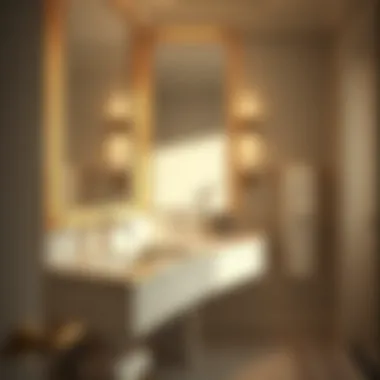
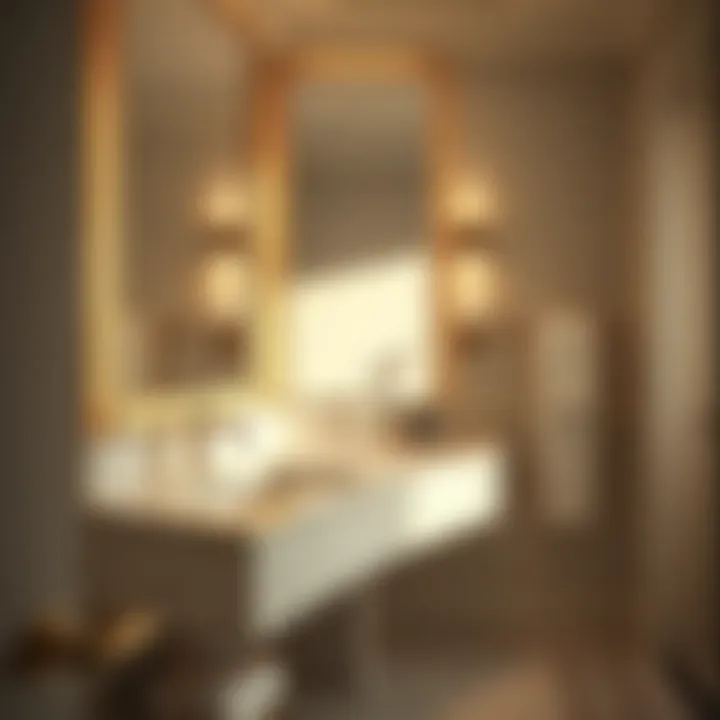
Intro
In the realm of interior design, the evolution of hotel bathrooms has made an indelible mark on the way we perceive and style our private spaces. Hotel bathroom vanities, in particular, serve as a focal point, bridging the gap between elegance and everyday practicality. Most travelers have experienced that touch of luxury found in hotel bathrooms. Now, why not bring that same feel into your own home? Through careful design choices and clever organization techniques, homeowners can not only enhance the aesthetic appeal of their bathrooms but also transform them into soothing retreats.
This article will dissect the various aspects of hotel bathroom vanities, from trending design styles to the materials that stand the test of time, embodying both durability and elegance. Moreover, it will shed light on organization techniques that turn chaos into order, culminating in a practical guide for the discerning homeowner seeking inspiration from hotel trends.
Let's dive into the current trends that define hotel vanities, focusing on the interplay between color palettes and the popularity of specific styles.
Current Trends
Hotel bathrooms are no longer mere utilitarian spaces; they are now mini-oases designed to rejuvenate and inspire. As such, current trends in hotel bathroom vanities reflect an increasing emphasis on style and functionality, catering to a modern audience that values both.
Color Palettes
With the surge of minimalism, many hotel designers are gravitating towards calming color palettes that refresh the spirit. Soft whites and soothing beiges create a bright, airy feel, while deeper hues like navy and charcoal add sophistication. Here are some popular color combinations observed in today’s hotel bathroom vanities:
- Warm neutrals: Beige and taupe create an inviting aura.
- Cool greys: Paired with white countertops, grey can lend an elegant touch.
- Bold accents: Deep jewel tones like emerald green or sapphire blue serve as striking highlights against lighter shades.
Popular Styles
Recognizing that every guest has unique tastes, hotels are also embracing a variety of design styles in their vanity selections. A glance at some of the most popular styles reveals a mix of contemporary flair and classic charm.
- Modern minimalist: Clean lines, integrated storage, and clutter-free spaces dominate this aesthetic.
- Rustic chic: Natural wood finishes paired with vintage sinks create a cozy, homey feel.
- Glamourous luxury: Expect opulent materials such as marble and gilded accents that elevate the ordinary into the extraordinary.
Hotel bathrooms today are a blend of art and functionality, strategically designed to satisfy both the eye and the need for comfort.
Visual Ideas
To fully appreciate the beauty of hotel bathrooms, a visual tour can be enlightening. Think about how many hotel bathrooms have made an impact on imaginings of personal spaces at home.
Gallery of Styled Bathrooms and Bedrooms
A curated collection showcasing different styles can provide valuable insights. From sleek modern designs to traditional glamour, each image tells a story about the choices made by designers.
Before-and-After Transformations
Highlighting real-life transformations showcases how effective changes can alter not merely the look, but the very essence of a bathroom.
"A simple vanity upgrade can turn an ordinary bathroom into a statement space."
In the next sections, we will delve deeper into the materials that frame these luxurious vanities and explore essential organization tips that professionals use to maintain a clean and inviting atmosphere.
Foreword to Hotel Bathroom Vanities
When one thinks of a hotel bathroom, it's often the vanity that stands out first. These bathroom vanities are more than mere fixtures; they play a pivotal role in creating both a functional and aesthetically pleasing environment. Vanities can be the lifeblood of a bathroom, combining style and utility in ways that resonate deeply with both guests and homeowners alike. This article aims to explore how these often overlooked elements of design can greatly transform spaces, providing a finer experience of comfort and luxury.
The Role of Vanities in Hotel Bathrooms
In hotel bathrooms, vanities are not just about the looks; they serve multiple essential functions. They provide ample sink space, storage solutions, and serve as a focal point where guests can prepare for their day. A well-designed vanity integrates seamlessly with the overall bathroom layout, offering a balance between cleanliness and elegance. Often accented by high-end countertops such as Carrara marble or quartz, these vanities may come with striking mirrors that amplify light, making the entire space feel larger and more inviting.
Moreover, thoughtful storage options are a trademark of hotel vanities. There may be hidden compartments for keeping personal items discreetly tucked away or open shelves displaying luxury toiletries. For instance, a vanity featuring both cabinets and drawers can address differing needs, allowing guests to have their space organized yet easily accessible. This careful arrangement ultimately enhances the guest experience, making it less about practical use and more about a feeling of indulgence.
In essence, vanities in hotel bathrooms encapsulate the harmony of form and function, inviting guests to experience a slice of luxury every time they enter the space.
Why Homeowners Look to Hotels for Inspiration
It's no surprise that many homeowners turn to hotels for inspiration when remodeling their own bathrooms. Hotels are designed to impress, aiming to create spaces that balance relaxation with utility. The attention to detail in hotel bathrooms often sets a high bar in elegance—something many homeowners desire to replicate.
A key draw is the curated look; hotel bathrooms often feature cohesive color schemes and luxurious materials. Homeowners can take notes from high-end establishments and incorporate elements like floating vanities or double sinks, which optimize functionality while maintaining a refined aesthetic.
- Material Choices: Homeowners might admire how costly materials, like granite, are coupled subtly with more affordable options to keep costs in check without compromising the overall vibe.
- Space Utilization: Those looking to maximize small areas can adopt ideas such as wall-mounted vanities or unique shelving, which hotels frequently use to make spaces feel airy and spacious.
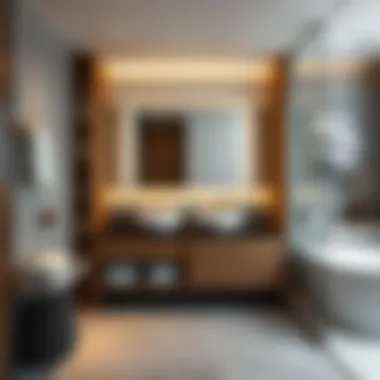
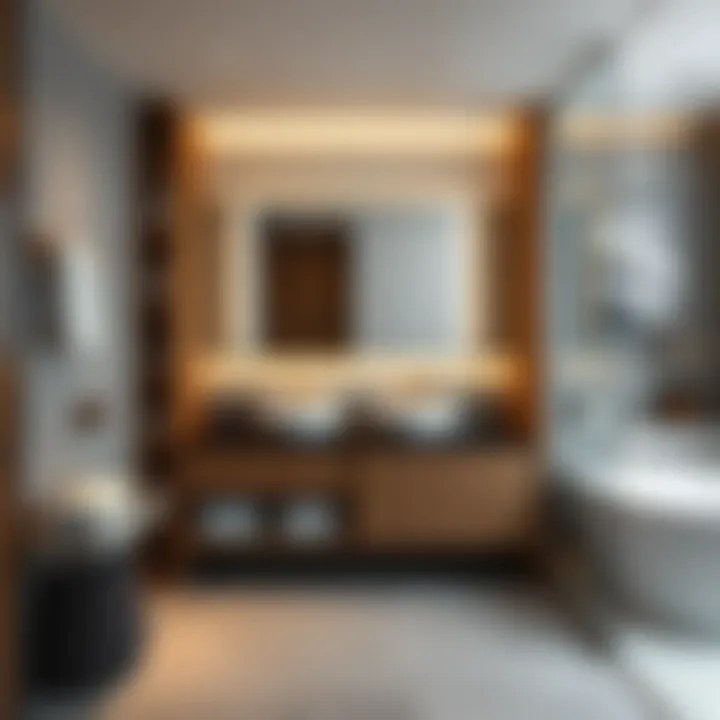
What's more, browsing through hotel design is like tapping into a treasure trove of modern trends. From smart bathrooms that integrate technology to sustainable choices in materials, such references often help inspire homeowners in their design choices. When attempting to create a bathroom that feels like an oasis, taking cues from high-end hotels not only ensures stylish results but also offers practical solutions to common space constraints.
Design Elements of Hotel Bathroom Vanities
The world of hotel bathroom vanities is vast and intricate, merging the functionality that travelers increasingly demand with the elegance that demands one’s attention. In today’s competitive hospitality market, vanities are more than just practical fixtures; they embody a brand's aesthetic and cater to guests' desires for luxury combined with usability. Therefore, understanding the design elements that comprise these vanities becomes essential, not just in hotels, but also for homeowners who seek to replicate that unique ambiance in their own spaces.
Materials Commonly Used
Marble
Marble is often touted as the quintessential luxury material. Its veins and patterns are nature’s artistry on display, bringing an opulent feel to any bathroom. One of its standout characteristics is its durability; properly sealed, marble can withstand the rigors of daily use. This makes it a prevalent choice for hotels that emphasize longevity without sacrificing style. However, with its beauty comes a price—literally. It can be quite costly compared to other materials, which might deter budget-conscious homeowners. Still, the unique feature of marble lies in its ability to elevate an ordinary bath into a lavish spa-like retreat. Yet, one must consider the maintenance, as it can stain easily if spills are not quickly addressed, posing a potential downside in high-traffic environments.
Granite
Granite, a close cousin of marble, boasts its own strengths. This natural stone is well-known for its resilience against scratches and heat. Its high-density structure makes it a safe bet for functionality, especially in hotel settings where there’s constant traffic and usage concerns. The significant hallmark of granite is its array of colors and patterns, providing homeowners with flexibility to match their personal style. However, it also requires sealing to be stain-resistant—though even with that, it’s less porous than marble, which works in its favor. On the downside, the hefty weight can necessitate reinforced cabinetry, complicating installation in some scenarios.
Wood
Wood adds warmth and a touch of nature, creating an inviting atmosphere. Using hardwoods in vanities can impart a sense of timelessness, making them popular in high-end hotels like well-known boutique stays. The rich textures of grains can complement a variety of decorative styles, enhancing a bathroom’s character. However, it’s vital to choose water-resistant finishes. Wood is susceptible to water damage, and its upkeep can be quite intensive, requiring regular sealing or refinishing to maintain its appearance. The unique feature of wooden vanities is their natural aesthetic, which can bring a comforting element into stark bathroom designs, allowing for an organic connection amid the more clinical aspects of typical hotel bathrooms.
Composite Materials
Composite materials have emerged as a modern alternative in vanity design. These engineered products combine different materials, often resulting in a highly durable and versatile solution. They can replicate the look of natural stone without the associated maintenance concerns. A primary characteristic of composites is their affordability and lightweight nature, making them easy to handle and install for homeowners looking to undertake DIY projects. One such variant, quartz composites, stand out for their non-porous surface which resists stains better than marble or granite, making clean-up a breeze. However, fitting them into a high-end aesthetic can sometimes be a challenge, and they may not carry the same prestige as natural stones for luxury hotels.
Color Schemes and Finishes
Neutral Tones
Neutral tones offer a versatile foundation in bathroom design. They provide a calming backdrop that welcomes personalization through decorative accents. Such colors can connote a clean and spacious feel—an important factor for hotels aiming to make small bathrooms appear larger. Especially popular are shades of white, beige, and taupe, creating a balanced harmony in the overall aesthetic. However, the drawback lies in their potential blandness; without thoughtful decoration, a neutral palette can come off as uninspired or lifeless. It's crucial to introduce texture or layered elements to avoid such pitfalls.
Bold Accents
In contrast, bold accents breathe life and vibrancy into a space—perfect for conveying a brand’s identity or mirroring trendy design movements. Hotel bathrooms may use deep blues or striking blacks to create a dramatic effect that captivates attention. The key characteristic of bold colors is their ability to evoke emotions and create focal points. While these hues can make a striking impression, they often require careful consideration, as overuse can lead to overwhelming spaces. Homeowners should weigh how such decisions can profoundly affect the inner workings of mood and perception in their own bathrooms.
Matte vs. Glossy Finishes
The choice between matte and glossy finishes has gained traction in contemporary designs. Matte finishes create a softer look, and they tend to hide water spots and smudges, presented as a practical choice in busy environments. Glossy finishes, on the other hand, reflect light and can create a sense of spaciousness, making them more common in smaller bathrooms. Each finish has its own unique feature; where matte offers a more subdued elegance, glossy presents a polished and sophisticated turn. The duality lies in personal preference, but each does carry both advantages and disadvantages that homeowners must contemplate while seeking to achieve their desired ambiance.
Functional Aspects of Bathroom Vanities
The utility of bathroom vanities goes beyond mere aesthetics; these structures serve as the backbone of functionality in any bathroom space. In hotels, where every square inch must cater to a seamless guest experience, the design and functionality of vanities take priority. Homeowners are increasingly borrowing ideas from these commercial settings to enhance their personal distributions. This section dives into various functional aspects of bathroom vanities that can significantly affect storage solutions and overall layout, all of which contribute to maximizing both space and convenience.
Storage Solutions
Drawers vs. Cabinets
When considering storage solutions, the choice between drawers and cabinets is a critical one. Drawers present a more streamlined method of access, allowing for organized storage of smaller items like toiletries and makeup. Their key characteristic is accessibility; you can pull out a drawer and see the entire contents at a glance, which solidifies their position as a popular choice for modern designs. On the flip side, cabinets tend to excel in hiding away larger items or less aesthetic essentials. They might offer less visibility, but they create a cleaner, more polished look, often favored in high-end hotel designs.
The unique feature of drawers is their adaptability; they can often include dividers to keep smaller items tidy. However, one disadvantage is that they can become messy if not organized properly. Cabinets require the extra step of opening doors, but they can be more versatile in terms of what they can hold externally, making them advantageous for overall space management.
Open Shelving
Open shelving has surged in popularity and for good reason. Its key characteristic lies in its ability to create an airy feel while simultaneously showcasing decorative items or essentials. The benefit here is two-fold: it adds to the decor while providing easy access to daily use items, which can be particularly appealing in a personal bathroom. In hotel bathrooms, open shelves allow for easy display of luxury toiletries, enhancing that upscale feeling which guests appreciate.
However, there are a few considerations—an open shelf can quickly turn into a cluttered space if organization is not kept in check. While they’re less cumbersome than cabinets, the need for maintenance to keep items looking fresh and organized is a must, especially if the vanity is centrally located in a shared bathroom.
Hidden Compartments
The idea of hidden compartments in a bathroom vanity is both intriguing and practical. Their key characteristic is discreet storage that keeps unsightly items out of sight, promoting a clean and organized space. This kind of setup is particularly beneficial in smaller bathrooms where maximizing every inch of space is crucial. By incorporating hidden compartments, homeowners can avoid clutter while still keeping all necessary items within reach.
Another advantage is that these compartments can be designed to fit unique items, from decorative plants to spare towels. But a potential drawback is the possible complexity they add to the design. People might forget about what’s stored away, and if the compartments are not intuitive to access, they could create more frustration than benefit. With thoughtful design, however, these hidden features can enhance usability and elevate everyday routines.
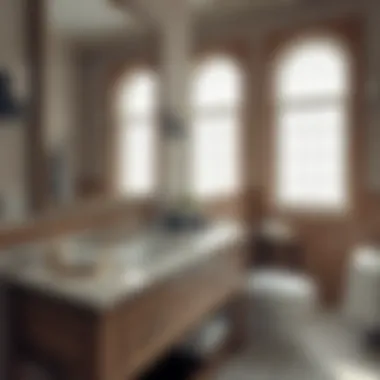
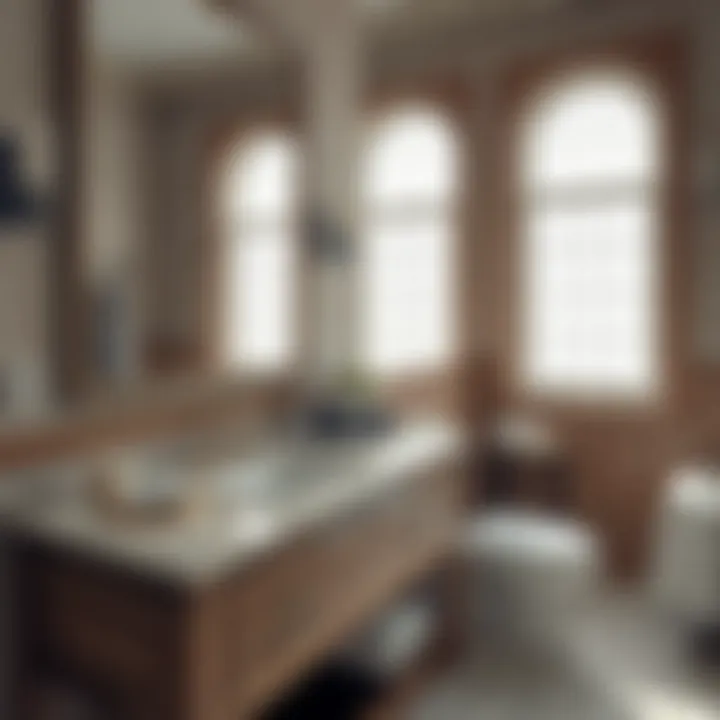
Intuitive Layout and Accessibility
An intuitive layout goes hand-in-hand with accessibility—a critical point of focus in both hotel and home bathroom design. It’s about creating a flow that allows for easy movement and usage, reducing the stress of cluttered spaces. In hotels, where guests often navigate unfamiliar settings, accessibility promotes satisfaction and comfort. At home, this same principle translates into a seamless morning routine.
A well-considered layout ensures that all elements—from the sink to the vanity storage—are positioned for user-friendly operations. Imagine a setup where toiletries are stored within arm's reach of the sink, or the towel rack is right beside the shower. These small considerations significantly improve the user experience.
Creating an accessible space doesn’t require additional square footage. Instead, it’s about strategic organization, like placing taller items in the back of cabinets and drawers, and lower ones within easy reach, especially in households with young children or elderly family members. The right layout not only enhances functionality but also positions the bathroom as a sanctuary rather than just a utility area.
In summary, the thoughtful integration of different storage solutions and an intuitive layout not only refines the aesthetic of bathroom vanities but also boosts practicality—perfect for creating a luxurious but functional environment conducive to relaxation and organization.
Leveraging these functional aspects can transform a bathroom vanity into a cornerstone of the space, accommodating both style and functionality.
Innovative Trends in Hotel Bathroom Vanities
In today’s ever-evolving design landscape, innovative trends in hotel bathroom vanities are pivotal not just for hospitality but also for the minds of homeowners seeking inspiration. Vanities are no longer mere functional stations but serve as statements of style and reflections of personal values. The blend of aesthetics and practicality, particularly concerning sustainability and modern technology, is a game-changer in both hotel and residential spaces.
Sustainable Materials and Practices
The growing awareness of environmental issues has propelled the use of sustainable materials in hotel bathroom vanities. Homeowners keen on eco-friendliness are taking notes from hotels that incorporate reclaimed wood, recycled glass, or bamboo into their designs. These materials do not only contribute to a reduced carbon footprint but offer unique aesthetics that can make a bathroom feel more organic and inviting.
"Sustainability isn't just a trend but a gradual shift towards mindful living; every choice matters."
Investing in sustainable practices translates to more than just material choice; it’s about how the vanity is crafted, installed, and maintained. By selecting low-VOC (volatile organic compounds) finishes, homeowners can create a healthier indoor environment. Incorporating plants or other natural elements enhances the ambiance, reminding us to bring a bit of the outside in. As more homeowners grow aware of their environmental impact, expect the trend of sustainable bathroom vanities to gain even more traction.
Smart Technology Integration
With technology seeping into every corner of our homes, the integration of smart technology into bathroom vanities is becoming a must-have. Homeowners are not only looking for convenience but also for how these innovations can enhance their daily routines. Smart mirrors, touchless faucets, and LED lighting are prime examples.
Smart Mirrors
Smart mirrors feature built-in technology that elevates the everyday experience. Beyond reflecting your image, they can display the weather, news updates, or even your daily schedule. Their capacity for multi-functionality makes them an appealing choice for those balancing a busy lifestyle. A noteworthy characteristic is their anti-fog feature, which keeps the mirror clear even after a hot shower, ensuring that they are as practical as they are modern.
While smart mirrors offer a higher price point, many find that their features justify the investment. However, it’s prudent to be aware of potential connectivity issues along with the need for regular updates to ensure optimal functioning.
Touchless Faucets
Touchless faucets represent a leap towards hygiene and water efficiency. Homeowners appreciate how these faucets activate with a simple wave of the hand, minimizing contact and enhancing cleanliness, especially in spaces that often harbor germs. With the emphasis on health, it's no wonder they are gaining traction in both hotel and home bathrooms alike.
The pivotal characteristic here is their water-saving technology, which can help reduce bills while also supporting conservation efforts. The downside, however, could be the occasional malfunction or the necessity for battery replacements, which can be a nuisance.
LED Lighting
LED lighting is not just an energy-efficient choice but also offers versatility in a bathroom setting. With adjustable options for color temperature, homeowners can curate the atmosphere to match their moods—from brightening up the space for morning routines to softening it for evening relaxation. This customizable lighting is an attractive feature for those looking to create a serene sanctuary.
Moreover, LED lights come with a longer lifespan than traditional bulbs, resulting in lower long-term costs. However, some may find that the initial installation can be pricey, which could dissuade those with tighter budgets.
Incorporating these innovative trends into bathroom vanities does far more than improve function and style; it helps set a tone of intentionality in space. As society becomes increasingly conscious of its choices, both aesthetic appeal and smart technology's benefits will continue to shape how we approach our private sanctuaries.
Comparative Analysis: Hotel vs. Home Vanities
The discussion surrounding bathroom vanities in hotels versus those found in homes provides valuable insights into design principles, functionality, and preference trends. This comparative analysis serves as a lens through which homeowners can draw inspiration from the luxury and efficiency seen in hotel environments. The primary focus is not just on aesthetics but also on how these designs address practical concerns unique to different settings.
Differences in Design Philosophy
When one considers the design philosophy between hotel and home vanities, there are distinct contrasts that emerge. Hotels often lean towards creating a spa-like experience. The goal is to provide an inviting atmosphere that encourages relaxation. Hotel bathroom vanities tend to feature bold finishes, high-end materials like marble or quartz, and cohesive color schemes that create visual harmony.
In contrast, home vanities are generally designed with a practical approach, taking into account daily usability and personal style. Homeowners often choose finishes and features that reflect their unique tastes and dimensions available. For instance, while a hotel might use a sleek, floating vanity to emphasize space, a home might require a more traditional setup with ample cabinet space to store everyday toiletries.
A few key distinctions include:
- Material Choices: Hotel vanities may use premium materials that convey luxury; homeowners prioritize durability and personal preference.
- Size and Scale: Hotels typically have larger spaces to work with, allowing for expansive vanities, whereas homes, especially smaller ones, need compact solutions that save space yet retain function.
- Customization: While hotels standardize their offerings to maintain a brand aesthetic, homeowners can customize based on individual needs and preferences.


Adaptability to Smaller Spaces
Size limitations in homes present unique challenges when it comes to bathroom vanities. In contrast to hotels, where space can often accommodate larger designs, homeowners often operate under constraints. As a result, the adaptability of vanities to smaller spaces becomes crucial.
- Multifunctional Designs: Many homeowners are exploring vanities that serve multiple purposes. A vanity can incorporate shelving, hidden compartments, or even mirrors that double as storage to maximize utility.
- Compact Models: Designs that emphasize compactness do not sacrifice style for function. Many modern vanities now come in sleek, minimalistic forms that can fit snugly into tight corners while still being visually appealing.
- Vertical Space Utilization: In smaller bathrooms, looking up can maximize storage. Vanities that offer vertical shelving or wall-mounted units help in managing limited floor space effectively.
The necessity of blending function with aesthetics creates a balancing act for those designing home vanities. By examining the strategies employed in hotel bathrooms, homeowners can glean innovative methods to optimize their own spaces, regardless of size.
Key Insight: Incorporating elements inspired by hotel vanities can transform a simple bathroom into an organized and elegant sanctuary, even in limited spaces.
These differences and considerations not only highlight the diverse approaches between hotel and home bathroom designs but also reflect the growing trend of personalization in home renovations. By understanding what works in hotels, homeowners can adapt various features to create bathrooms that serve their lifestyles well without compromising elegance or style.
DIY Your Own Hotel-Style Bathroom Vanity
Creating a DIY hotel-style bathroom vanity allows homeowners to infuse a touch of luxury into their personal spaces without spending a fortune. More than just a functional fixture, the vanity holds a significant role in the overall design of the bathroom. It can be the centerpiece that ties the room together, providing both beauty and practicality. Understanding the ins and outs of this process ensures that individuals can not only replicate the elegance seen in hotel bathrooms but also personalize their vanity to match their unique taste and needs.
Why Go DIY?
Choosing to craft your vanity instead of purchasing a premade model can lead to a variety of benefits. Not only does it often prove to be more economical, but the customization options are endless. A DIY approach fosters creativity and allows you to choose your materials, colors, and overall style. Moreover, it can result in a true sense of satisfaction, giving you that ‘hands-on’ reward at completion. If you're considering a renovation, think about how you can make your vanity a one-of-a-kind statement.
Selecting the Right Vanity Base
The vanity base is the foundation of your design. It sets the tone, style, and functionality of the entire ensemble. When selecting your base, consider different options like wood, metal, or even repurposed furniture. Each material can lend a different feel to your bathroom:
- Solid Wood: Offers a classic, warm texture. Although it may require treatment to protect against humidity.
- Plywood or MDF: More affordable choices that can be painted or stained to achieve your desired look.
- Upcycled Furniture: Think outside the box. An old dresser can be transformed beautifully into a vanity with some modifications.
Pay attention as well to the size and layout of your space. Measuring carefully will provide insight into what will fit comfortably without overcrowding. Consider the accessibility too; your vanity should compliment movement instead of blocking it.
Choosing Countertops and Sinks
Once the base is established, it's time to think about countertops and sinks, which should harmonize with your vanity and overall bathroom aesthetic. Here’s where you can really showcase personality:
- Countertops: Popular choices like granite, quartz, or even concrete bring durability and style.
- Sinks: Depending on your design, you can opt for vessel sinks that sit on top of the counter or under-mount sinks that provide a streamlined look.
Choose tones and styles that either contrast or complement your base and countertop to create that hotel-like ambiance.
- Granite: Each slab is unique, giving a luxurious touch.
- Quartz: A low-maintenance yet high-sheen surface.
- Concrete: Offers a modern and industrial feel.
Tips for Installation and Setup
Now onto the nitty-gritty of installation. Do-it-yourself projects can be intimidating, but breaking things down step-by-step simplifies the process:
- Prepping Your Space: Ensure that the area is clear and clean. Remove any existing fixtures carefully.
- Dry Fitting Components: Before securing anything, place your vanity and countertop in their intended locations to visualize the outcome effectively.
- Securing the Vanity: Attach it to the wall for stability, especially if it is on the heavier side or off the ground.
- Plumbing Installations: Be mindful of water connections. If you’re not comfortable with plumbing, it’s wise to consult a professional to avoid future headaches.
- Finishing Touches: This includes caulking edges, affixing handles, and adding decorative elements that resonate with your personal flair.
By focusing on these elements, anyone can successfully create a hotel-style bathroom vanity that enhances both style and functionality. Little adjustments can make a big difference, transforming an ordinary bathroom into a personal retreat.
"Creating a vanity that combines style and functionality not only improves the look of your bathroom but also makes daily routines a bit more enjoyable."
For more inspiration and tips, check sources like Wikipedia and home improvement platforms such as Home Depot for guides and products.
Ending
In wrapping up our exploration of hotel bathroom vanities, it's vital to recognize the profound impact these design elements have on not only the aesthetic but also the functionality of any bathroom space. This article provided a thorough examination of how hotel vanities serve as the bridge between elegance and utility—inspiring homeowners to transform their ordinary bathrooms into inviting retreats.
Recap of Key Points Discussed
Reflecting on our journey through the ins and outs of vanities:
- Design Elements: We discussed the materials such as marble and wood that contribute to the luxurious look, alongside effective color schemes that can enhance overall ambiance.
- Functionalities: The emphasis on storage solutions was highlighted, including the practicality of drawers versus cabinets, and the need for intuitive layout facilitating easy access.
- Trendy Innovations: The rise of sustainable materials and smart technology—like touchless faucets—demonstrated how modern solutions integrate into daily life while keeping elegance intact.
- DIY Inspiration: For those looking to create their personal hotel-style bathroom, the step-by-step guidelines offered a practical approach from selecting the right vanity base to the nuances of installation.
Understanding these elements equips homeowners with the knowledge to create bathrooms that not only provide a touch of luxury but also meet their personal and practical needs.
Encouragement for Personalization
Lastly, and perhaps most importantly, we encourage readers to embrace their unique style. Bathroom vanities should reflect individual taste. The charm of a bathroom lies in its customization—adding personal touches like handmade decor, favorite colors, or unique fixtures makes a space truly your own. When selecting materials or deciding on layout, think about how each element can express your identity and comfort.
- Experiment with Colors: Don’t be afraid to introduce bold colors that resonate with your personality or opt for soft neutrals that induce tranquility.
- Mix Materials: Combine various materials; a wooden base with a sleek marble top can lend a fresh appeal to your vanity.
- Integrate Personal Design Elements: Showcase cherished items or artwork that holds meaning for you; they can serve as excellent conversation starters.
By incorporating personal choices into the bathroom design, you create not just a functional space but a sanctuary that reflects your lifestyle and priorities.
"A bathroom is more than just a functional space; it’s where you start and end each day. Make it yours."
Further insights can be nurtured by engaging with platforms that dive into home improvement and design. You may find excellent guidance at sites like Pinterest and Houzz that offer endless inspiration.



